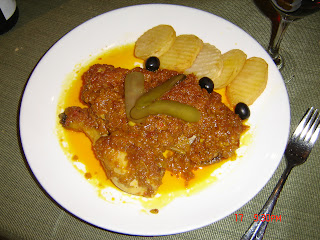大学時代の友人と会うため、マカオと香港に行ってきました。マカオは16世紀にポルトガルの植民地として発展し、ポルトガルと同じ街並みが残る町です。1999年の中国への返還後も自治が両国間で承認され、今も2000人ほどのポルトガル人が住んでいます。ここには日本と同じようにポルトガル料理の影響を受け、独自に発展した『マカオ料理というものがあります。また、当然ながら、中国の広東料理やポルトガル料理も味わえます。まずは、久しぶりに本当のポルトガル料理を味わおうと、香港空港で待ち合わせ2度の通関を通って『アントニオ』というポルトガル郷土料理の店に行きました。
Macao can be an ideal place to visit for those who wish to go to Europe or North America (let's say "Western countries") but do not have enough money or time. (It is logical that China, Korea, Japan are called "Far East" in Western countries.)
There are several reasons for this. First of all, the historic district of Macao has buildings, streets, monuments parks and gardens which resemble "Europe". To be more specific, you would feel as if you find yourself somewhere in Portugal. Yes, of course, As you may know, Macao was colonised by Portugal in the 16th century and belonged to them till 1999. Churches, architectures, statues and pavements were built in the style which you find in Portugal. Secondary, you can find some authentic Portuguese restaurant where a native Portuguese cooks.
"Antonio" is a good example and Mr. Coelho dedicates to serve original recipes from his birthplace to customers. He is also kind enough to have replied me when I booked a table by email. Nuno,Lu and I had first dinner at Antonio's.

Relatively expensive. Considering the fact that many ingredients such as cheese, sausages, Iberian pork and a large selection of wines are imported from Portugal, it is worth paying. Let's not forget the quality is high, too.
Maybe I should stop writing "boring" critics and show some photos which you want to see: Food.
+(%E3%83%9D%E3%83%AB%E3%83%88%E3%82%AC%E3%83%AB%E7%94%A3%E3%82%AA%E3%83%AA%E3%83%BC%E3%83%96).JPG) Azeituna de Portugal (Olives from Portugal / ポルトガル産オリーブ)
Azeituna de Portugal (Olives from Portugal / ポルトガル産オリーブ)
(English)
These are olives that I had at "Antonio restaurant" in Macao. As you can see, they are varied in colour, from yellowish colour, to dark brown and black. I am not knowledgeable about olives.
I suppose that the varied colours represent different stages of maduration when cultivation take place. Thus, taste can be different. Of course, different variety of olive can have different tastes. But for majority of customers except gastronomic expert, the most important thing is freshness and quality, not varieties. These olives I had are excellent. I believe the quality differs largely how olives are processed. Probably, these olives are dispatched to a packing factory or process at the farm immediately before the quality is deteriorated and processed adequately. On the other hand, olives found at ordinary supermarkets are almost tasteless compared with the one I had there. They are processed at factory in a way that canned products can last more than one year and kept on shelf for a long time. I could say no wonder olives are not popular in Japan at all even though medeterranian food is very popular.
(Japanese)
ポルトガルで郷土料理を提供するレストランへ行くと、写真のような色鮮やかなオリーブが食前に運ばれて来ることがあります。 オリーブが食前に注文に含まれていなくても出されるのはポルトガルやスペインでは普通の事です。それを見てそのレストランに 質をはかることができるとも言えます。オリーブは熟成度に寄って色が変化し、林檎などと同じように最初は緑色をしていて徐々に黄色く変化します。それから赤みをおびえてきて紫、あるいは茶色に変化し、最後に黒く変わります。風味も熟成度によって変わります。当然ながら品種によっても変わるでしょう。ただ、私たち日本人にとって一般に国内で口にする、食料品店で売っている缶詰のものと比べると味は雲泥の差と言えるでしょう。オリーブの実がどのような過程を通って人々の口に運ばれるか詳しく知りませんが、このようなレストランで出されるものと缶詰加工にされるものとでは収穫されてから梱包されるまで大きな違いがあるのは確実でしょう。イタリア料理などが日本に普及してパスタなどの麺類は日本に従来ある麺類と比べ需要が明らかに上がっていますが、オリーブの消費はほとんどないように感じます。もちろん日本と地中海沿岸のヨーロッパ諸国とでは食の違いが大きいですが、新鮮でおいしいオリーブが入ってこないことは大きな要因ではないかと思われます。
(%E3%83%9D%E3%83%AB%E3%83%88%E3%82%AC%E3%83%AB%E7%94%A3%E3%81%AE%E3%82%BD%E3%83%BC%E3%82%BB%E3%83%BC%E3%82%B8%E3%81%AE%E7%9B%9B%E3%82%8A%E5%90%88%E3%82%8F%E3%81%9B).JPG) Presunto e Enchidos Caseiros (Selection of Portuguese Smoked Ham and Sausage/ポルトガル産のソーセージの盛り合わせ)
Presunto e Enchidos Caseiros (Selection of Portuguese Smoked Ham and Sausage/ポルトガル産のソーセージの盛り合わせ) ポルトガルやスペインのソーセージ、一般に腸詰類は他のヨーロッパ諸国のものとその特徴が大きく異なり、日本人が通常期待するソーセージとは違った、変わったものを味わいが楽しめると言えるかもしれません。詳しくはありませんが塩コショウ以外に右と左のもののように甘みのある赤いパプリカを混ぜ込んあり、荒挽きの脂肪の塊が入っているのがその典型と言えるでしょう。日本人が知っているソーセージよりも塩気が強く、しっかりした味付けです。イタリア人もそうですがこの地域の人たちの食事を見ると塩味がしっかりしています。あまり減塩のいうことは考えないようです。色の濃く黒に近いソーセージは赤ワインあるいは豚の血が入ったものもあります。比較的白い色のソーセージには酢を混ぜることもあり、熟成方法も風通しのよい山間の貯蔵庫で熟成させたものや火であぶったスモークまで多様です。ポルトガルもスペインと同じように『ハモン・イベリコ(Jamón Iberico)』の産地です。一般的に『 プレスント・デ・ポルコプレト(
Presunto de porco preto)』といい、スペインに近いアレンテージョ地方のバランコス産(Barrancos)のものが最高とされています。残念ながらポルトガルの首都リスボンでさえ、加工肉を扱っている店の多くはスペイン産のハモン・イベリコを置いてなかなか手に入れるのも一苦労です。
+(%E3%83%9D%E3%83%AB%E3%83%88%E3%82%AC%E3%83%AB%E7%94%A3%E3%83%81%E3%83%BC%E3%82%BA%E3%81%AE%E7%9B%9B%E3%82%8A%E5%90%88%E3%82%8F%E3%81%9B).JPG) Tábua de Queijos Portugueses (Assorted Portuguese Cheese / ポルトガル産チーズの盛り合わせ)
Tábua de Queijos Portugueses (Assorted Portuguese Cheese / ポルトガル産チーズの盛り合わせ)
(Japanese)
チーズは最も興味のある食材の一つです。日本に伝わったのは明治に始まった西洋化あるいは第二次世界大戦後であるか熟知していませんが、高度成長期にプロセスチーズなるものが普及し始めてはじめて一般人がチーズを食するようになりました。プロセスチーズと対照的な本当のチーズは通常『ナチュラルチーズ』と称されています。私が興味があるのは後者の方です。ただチーズと言っても、種類や風味は多種多様です。たとえば、ミルクが牛、羊、山羊などどの家畜から絞ったものかで味は変わるのは当然のことですが、動物が放牧されて食べる牧草によって風味は変わってきます。ほとんど熟成していないチーズと1カ月ほどの熟成したチーズと3年の熟成を終えたチーズでは全く触感も味も香りを異なります。特に昔ながらの方法でほとんど機械に頼らず作られてきたチーズは格別です。ポルトガルにもそうしたチーズはたくさんあります。ポルトガル語やスペイン語の勉強のためにネットでニュースを見ていると昔ながらの羊の放牧に参加するツアープログラムを紹介していて、行ってみようかと思ったくらいです。伝統的に作られてきたポルトガルのチーズは羊及び山羊のチーズあるいはこの混合がほとんどです。スペイン南部とポルトガルにしか見られないタイプに近いのが写真の真ん中のチーズ。布で丸いチーズの側面を包んで熟成させるもので、皮の部分も柔らかくそのまま食します。中はバターが解けたようにどろっとしており、ナイフできると形が崩れてきます。通常、こうしたチーズは、『Queijo amanteigado(ケイジョ・アマンテイガード)』と呼ばれいます。『manteiga (マンテイガ)』はポルトガル語で『バター』を意味し、その名の通り『バター状チーズ』言えます。
(Spanish)
Quesos... Los que me gustan más de la Europa son quesos. Queso de ovejas y cabras son especialidades de los paises ibericos. Queria ir allí para provar varios quesos. Quesos artesanos casí nunca vienen aqui!
+(%E3%83%9D%E3%83%AB%E3%83%88%E3%82%AC%E3%83%AB%E7%94%A3%E3%82%A4%E3%83%99%E3%83%AA%E3%82%B3%E8%B1%9A%E3%81%AE%E3%82%B0%E3%83%AA%E3%83%AB).JPG) Secretos de Porco Preto Grelhados (Black Pork Fillets on Charcoal/ポルトガル産イベリコ豚のグリル)
Secretos de Porco Preto Grelhados (Black Pork Fillets on Charcoal/ポルトガル産イベリコ豚のグリル)
(English)
I had some Iberian pork steak for a main course. The meat is imported from Portugal in this restaurant, along with other ingredients such as cheese and sausages. As you may know, iberian pigs are reared in acorn grove a certain period in order to give them exercise to develop some muscle. This condition gives less fat and slightly taugher texture. Pigs are fed with acorn, which gives an mistakable taste in meat. Iberian pork is certainly my favorite.
(Japanese)
メインにはポルトガル産のイベリコ豚のステーキを食べました。このレストランではチーズやソーセージなどの食材に加えて豚肉もポルトガルより輸入したものを使用しています。 イベリコ豚はスペイン南部のアンダルシア・エクストラマドゥーラ地方とそこに隣接したポルトガル アレンテージョ地方特産の品種で一定の期間野山に放牧され、十分な運動を取らせることで筋肉を養わせ独自の食感を肉に与えます。また、その間ドングリの実を餌として食べさせることが肉に他の豚肉とは大きく違った味をだすとされています。
日本の和牛は非常に美味ですが、豚肉に関しては国内のものはこのイベリコ豚の味には太刀打ちできないと思います。豚肉は調理法も様々で腸詰めなどにもされ多様な食べ方で楽しめますが、日本で塩、胡椒だけで味付けして焼いたものを料理として出すことがほとんどないことからしてもイベリコ豚との差が窺えるように思います。
(Spanish)
Esto es una especialidad de Portugal y España Creo que vosotros sabeis "secreto de cerdo iberico, la parte más rico de este animal. Penso que la mayoria de la gente en España prefieran jamon. Para mi, carne asado es un modo favorito para desgustar.
+(%E9%AD%9A%E4%BB%8B%E9%A1%9E%E3%81%AE%E3%83%AA%E3%82%BE%E3%83%83%E3%83%88).JPG) Arroz de Mariscos (Seafood rice / 魚介類のリゾット)
Arroz de Mariscos (Seafood rice / 魚介類のリゾット)
.JPG)
(English)
I love "espresso". After a large meal, I can't live without it. When I drink "espresso", I do not take any sugar. I remember that someone said in this situation, knowing that I drink it without sugar, "You, Japanese do not put any sugar in your tea. Why?".
I could not find any rational answer for it for a long time. Some historical background and certain different sense of taste may contribute to this custom. First of all, tea was introduced by Buddhist monks in the 6th or 7th century from China. By that time, the only food which contains some sweetness are fruit or nuts.
Sugar was brought by Portuguese during the 16th century and at that time, sugar was a luxury item which aristcrats or highly-ranked government officials and their family can get it easily. In the late 17th century the development of high sugar refining technology contributed to a large spread of sweet in commoners.
On the other hand, in Europe, Portuguese and Spanish brought back coffee and cacao from South America along with a sugar plant. Refining sugar and coffee processing technics were developed in the same period. Therefore, it is logical for people to start drink such a bitter beverage with refined sugar and invented chocolate with cacao and sugar.
Secondly, we could say that the Japanese enjoy the contrast of taste in a meal. It is our traditon to drink green tea or any types of Japanese tea without sugar. However, confectionary which accompanies normally contains a high degree of sweetness because the Japanese confectionary, "wagashi" is usually made with a large quantity of sugar. Thus
it is logical not to put any sugar into tea. This idea of the contrast of taste can be seen in a traditional Japanese meal. For example, rice is linsed and steamed with cold water, thus the taste is simple and plain. A main dish is normally cooked with soysauce or other seasonings. Therefore it is salty. At a household, we are taught to eat rice and a main dish or soup in turn.
In this way, there is no need to add any flavour in a plain rice. Going back to my discussion on how I drink my coffee, I may enjoy this contrast of taste: bitter coffee and sweets.
(Japanese)
食後に欠かせないものが、一杯のエスプレッソ。日本人ながら、この一杯に勝るものはないと言っていいでしょう。外国の友人も日本の友人も私がこの濃いコーヒーに砂糖を入れないことに驚きます。ただ、オーストラリアに初めて語学留学したときに味わってから15年以上この方法で飲んでいると苦みが甘みに感じると言うのでしょうか。本当に上手に入れたものはそのように感じます。この事どうしてか考えているとふと『西洋人が日本人にお茶には砂糖を入れないのか?』質問する光景を思い浮かべました。確かにこの質問は日本茶を飲むときに時々友人からも問われたものです。様々考えたある結論に達しました。それには複数の理由や要因があるのでないかと思います。まず一つは歴史的背景:お茶は仏教と時を同じくして6,7世紀ごろに日本に伝来したものでしょう。当時、砂糖なるものは存在せず、甘みのあるものといえば、果物でした。砂糖は16世紀ごろ、ポルトガル人によってもたらされました。(別の説によると中国からもたらされた。)合わせて砂糖と小麦を使い『南蛮菓子』なるものも作られるようになりますが、砂糖は高級品とされ
普通に庶民が手に入らなかったといいます。このことからもお茶に砂糖を入れるという発想を生まれなかった言えます。一方欧州では、15世紀からの『大航海時代』にスペイン及びポルトガルは航路を開きアジアへ、アメリカへと進出していきます。彼らはコーヒーやカカオなどを南米大陸から持ち帰りそこで手に入れた砂糖となる植物とその精製技術を生かし、生産を始めます。ポルトガルはマデイラ島を拠点に砂糖を生産し、ヨーロッパ諸国に輸出したとされています。これらがほぼ同時期に伝わったことを考えて、コーヒーを飲みやすく、カカオと砂糖ででチョコレートを作るというのは当然の発想だったのではと言えるでしょう。お茶はいつ欧州に伝わったか。これは大英帝国が中国で入手し、精製技術を学び、17世紀植民地としていたインドで生産し、国に伝えたとされています。当然、そのときには砂糖が英国にあったので砂糖をいれるようになったといえないでしょうか。
もうひとつは、日本人の食に対する姿勢によるといえます。日本人は、食事をする際にそれぞれの料理に味のコントラストを重視し、それぞれの料理を堪能するという考えがあるように思われます。先にのべたように、砂糖が日本に伝来し、甘い菓子が作られるようになります。徐々に精製技術が進み、安価で砂糖が手に入るようになると一般庶民の間でも和菓子が作られ、食べられるようになります。餡子の入った饅頭や羊羹は非常に甘いものです。これに苦みのある日本茶を合わせて飲むのは丁度よいと感じるのではないでしょうか。西洋人には甘すぎると感じる人が多いようです。それはつまり、日本人のようにその甘さを緑茶の苦みで調和させるような日本人の感覚がなく、お茶(紅茶)には砂糖を入れて飲むのが通常だからといってもいいのではないでしょうか。また、料理のコントラストは別の料理にも当てはまります。本来、日本人は米は冷水で砥ぎ塩など何もいれず焚きます。炊きあがった米とおかずになるものを交互に食べるのが正しい食べ方とされています。素朴で調味されいない御飯を醤油や塩で味付けされた主菜やみそ汁を一口ずつ口に運ぶことでそれぞれの味覚を楽しんでいるとも言えるのではないでしょうか。海外で生活しているときに外国人の何度か聞かれたことがあるのが『どうして日本人はそんな味の付いていないものを食べるのか』ということです。その答えは先に述べた味のコントラストではないかと思われます。
.JPG)
(English)
Since my Portuguese friend is a patriot who always try to visit a place where his ancestors left some footprints in its history, I brought some sweets that he could not tried in his visit in Japan. This is called "marubolo", literally "round cake". It is said that this sweet was originally designed to be carried along by Portuguese sailors when they set out for long voyage. Between 16th and 17th centuries many Portugueses missionaries and merchants settled in Nagasaki. A great variety of sweets and cakes were developed and passed down from generation to generaltion in "Nagasaki" and "Saga", surrounding regions. It is very interesting to tell him stories related to these confectionaries originated to his country. "Marobolo" is mainly made of white flour, egg yolk, sugar, honey and syrup. The mixture is knelt and baked in oven. Interestingly, according to the book written by Mr. Muraoka, the president of this sweet maker, it is said that missionaries taught local people the techniques to grow wheat. "Saga" - where the sweet had become one of main regions of producing wheat. Like this company, many sweet producers use exclusively locally-grown flour to bake traditonal cakes. It is said that the local product give a specific texture and taste.
(Japanese)
マカオで会う友達がこれまで大航海時代などポルトガル人が歴史上訪れてその地に大きな形跡を残した国を好んで旅をしていたことを知っていたため、南蛮菓子の代表である『丸ぼうろ』を持参して見ました。名前は書かれた字のごとくポルトガル語の『Bolo(ボーロ)=菓子』と日本語の『丸い』を結合してできたものです。『小城羊羹』の老舗である村岡総本舗の経営者である村岡安廣先生の書かれた『肥前の菓子』には、16世紀に来航したポルトガル人から伝わったもので、非常食として水夫が携帯していたものが原形だということです。また、16世紀から18・19世紀にかけて小麦粉で作られた南蛮菓子が佐賀で発展し受け継がれた原因の一つにはポルトガル人をはじめとする欧州の宣教師たちがキリスト教を布教するなかで地元の人々に小麦の農法伝え、パンなど食糧に精製する方法を教えたことが挙げられます。また、それにより佐賀は小麦の産地として知られるように生産量も増え、私は白玉饅頭を作っているお店で初めて知ったのですがそれは地粉(ぢご)と呼ばれ、『丸ぼうろ』などには長年、苦労して作りあげた独特の食感を与えるものとしてあえて厳選して使われているようです。村岡総本舗は羊羹の製造で有名ですが、『丸ぼうろ』、『有平糖』など南蛮菓子も作っています。
詳しくは
村岡総本舗 http://www.muraoka-sohonpo.co.jp/ 『肥前の菓子 シュガーロード長崎街道を行く』・村岡安廣著 参照
(Português)
Os pratos do restaurante Antonio são optimos. Basicamente, são as comidas tradicionais e doses são enormes. São Caros porque todos os ingredientes necessarios são importado de Portugal, nomeadamente, carnes, queijos, presuntos e enchidos. O prato pricipal que tomei foi secreto de Porco Preto grelhados, parte mais rico do animal. Todos os pratos foram deliciosos. Se viverem e trabalharem em Hong Kong ou Macau e quiserem as comidas autenticas mas não tiverem suficiente tempo para voltar a Portugual, este restaurante seria seleto.
レストラン・『アントニオ』 / Antonio Restaurant (Macau)
Address : 澳門仔舊城區客商街3號地下安東尼奧 (Rua dos Negociantes No. 3, Old Taipa Village, Taipa, Macau)
Phone : (853) 2899 9998
Opening hours : ランチ 昼12:00~3:00PM(月-金)/ディナー 6:00PM~L.O.10:30PM(月-金)/昼12:00~L.O.10:30PM(土・日・祝)
Closed : 無休
Email : reservations@antoniomacau.com
Website : http://www.antoniomacau.com/index.htm
.JPG)

.JPG)




.JPG)
.JPG)
.JPG)
.JPG)


















.JPG)








+(%E3%83%9D%E3%83%AB%E3%83%88%E3%82%AC%E3%83%AB%E7%94%A3%E3%82%AA%E3%83%AA%E3%83%BC%E3%83%96).JPG)
(%E3%83%9D%E3%83%AB%E3%83%88%E3%82%AC%E3%83%AB%E7%94%A3%E3%81%AE%E3%82%BD%E3%83%BC%E3%82%BB%E3%83%BC%E3%82%B8%E3%81%AE%E7%9B%9B%E3%82%8A%E5%90%88%E3%82%8F%E3%81%9B).JPG)
+(%E3%83%9D%E3%83%AB%E3%83%88%E3%82%AC%E3%83%AB%E7%94%A3%E3%83%81%E3%83%BC%E3%82%BA%E3%81%AE%E7%9B%9B%E3%82%8A%E5%90%88%E3%82%8F%E3%81%9B).JPG)
+(%E3%83%9D%E3%83%AB%E3%83%88%E3%82%AC%E3%83%AB%E7%94%A3%E3%82%A4%E3%83%99%E3%83%AA%E3%82%B3%E8%B1%9A%E3%81%AE%E3%82%B0%E3%83%AA%E3%83%AB).JPG)
+(%E9%AD%9A%E4%BB%8B%E9%A1%9E%E3%81%AE%E3%83%AA%E3%82%BE%E3%83%83%E3%83%88).JPG)
.JPG)
.JPG)